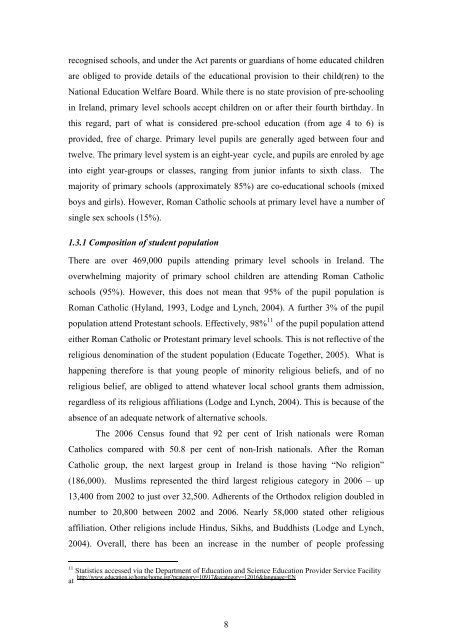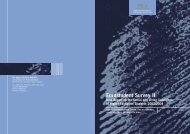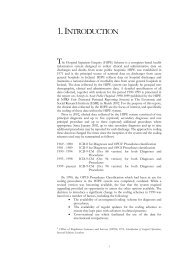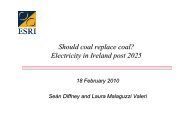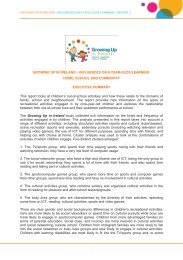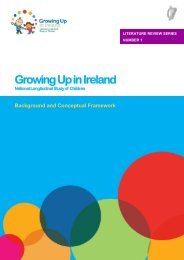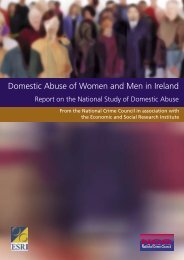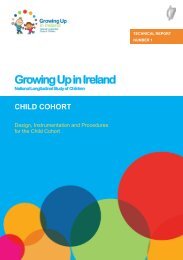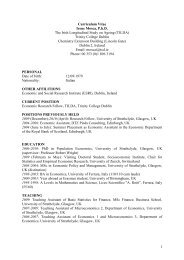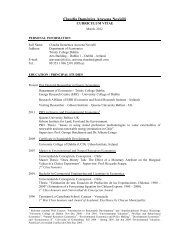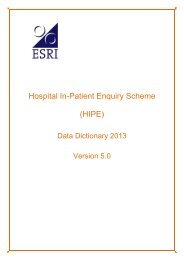Working paper country note: ireland kathleen lynch - ESRI
Working paper country note: ireland kathleen lynch - ESRI
Working paper country note: ireland kathleen lynch - ESRI
You also want an ePaper? Increase the reach of your titles
YUMPU automatically turns print PDFs into web optimized ePapers that Google loves.
ecognised schools, and under the Act parents or guardians of home educated children<br />
are obliged to provide details of the educational provision to their child(ren) to the<br />
National Education Welfare Board. While there is no state provision of pre-schooling<br />
in Ireland, primary level schools accept children on or after their fourth birthday. In<br />
this regard, part of what is considered pre-school education (from age 4 to 6) is<br />
provided, free of charge. Primary level pupils are generally aged between four and<br />
twelve. The primary level system is an eight-year cycle, and pupils are enroled by age<br />
into eight year-groups or classes, ranging from junior infants to sixth class. The<br />
majority of primary schools (approximately 85%) are co-educational schools (mixed<br />
boys and girls). However, Roman Catholic schools at primary level have a number of<br />
single sex schools (15%).<br />
1.3.1 Composition of student population<br />
There are over 469,000 pupils attending primary level schools in Ireland. The<br />
overwhelming majority of primary school children are attending Roman Catholic<br />
schools (95%). However, this does not mean that 95% of the pupil population is<br />
Roman Catholic (Hyland, 1993, Lodge and Lynch, 2004). A further 3% of the pupil<br />
population attend Protestant schools. Effectively, 98% 11 of the pupil population attend<br />
either Roman Catholic or Protestant primary level schools. This is not reflective of the<br />
religious denomination of the student population (Educate Together, 2005). What is<br />
happening therefore is that young people of minority religious beliefs, and of no<br />
religious belief, are obliged to attend whatever local school grants them admission,<br />
regardless of its religious affiliations (Lodge and Lynch, 2004). This is because of the<br />
absence of an adequate network of alternative schools.<br />
The 2006 Census found that 92 per cent of Irish nationals were Roman<br />
Catholics compared with 50.8 per cent of non-Irish nationals. After the Roman<br />
Catholic group, the next largest group in Ireland is those having “No religion”<br />
(186,000). Muslims represented the third largest religious category in 2006 – up<br />
13,400 from 2002 to just over 32,500. Adherents of the Orthodox religion doubled in<br />
number to 20,800 between 2002 and 2006. Nearly 58,000 stated other religious<br />
affiliation. Other religions include Hindus, Sikhs, and Buddhists (Lodge and Lynch,<br />
2004). Overall, there has been an increase in the number of people professing<br />
11 Statistics accessed via the Department of Education and Science Education Provider Service Facility<br />
at http://www.education.ie/home/home.jsp?pcategory=10917&ecategory=12016&language=EN<br />
8


